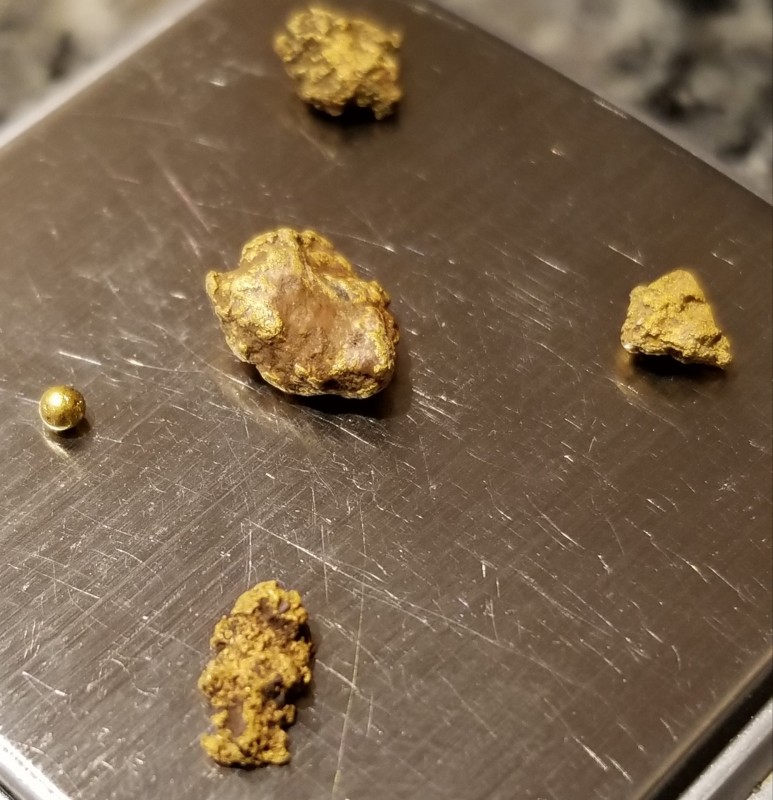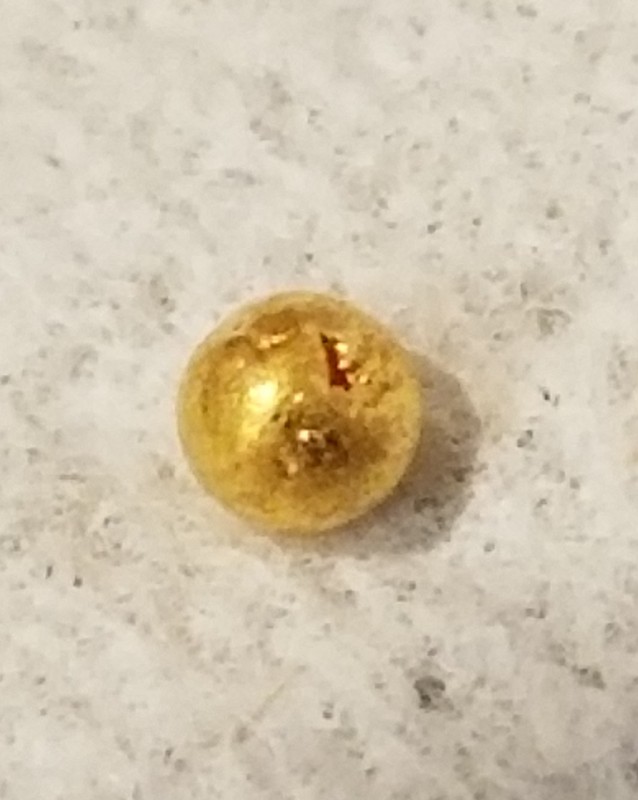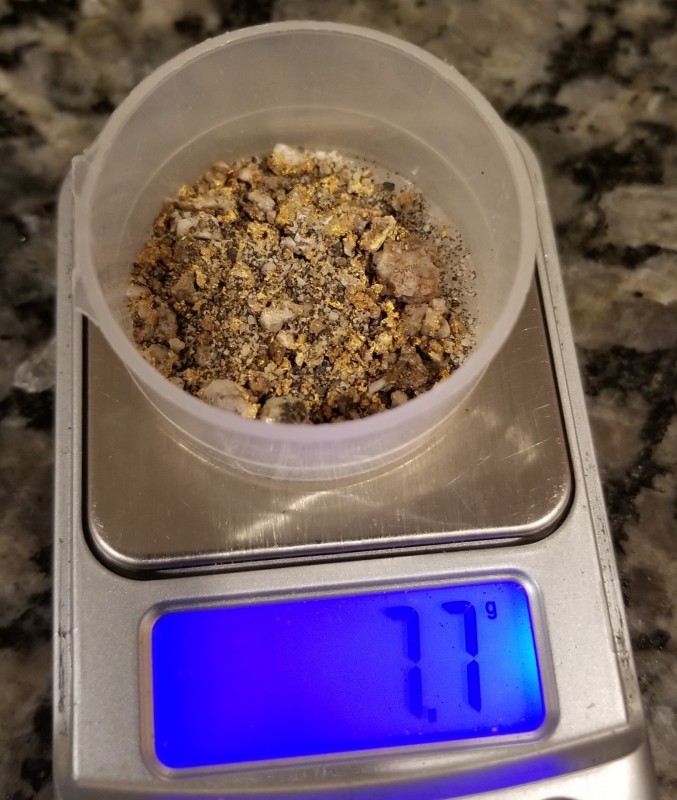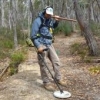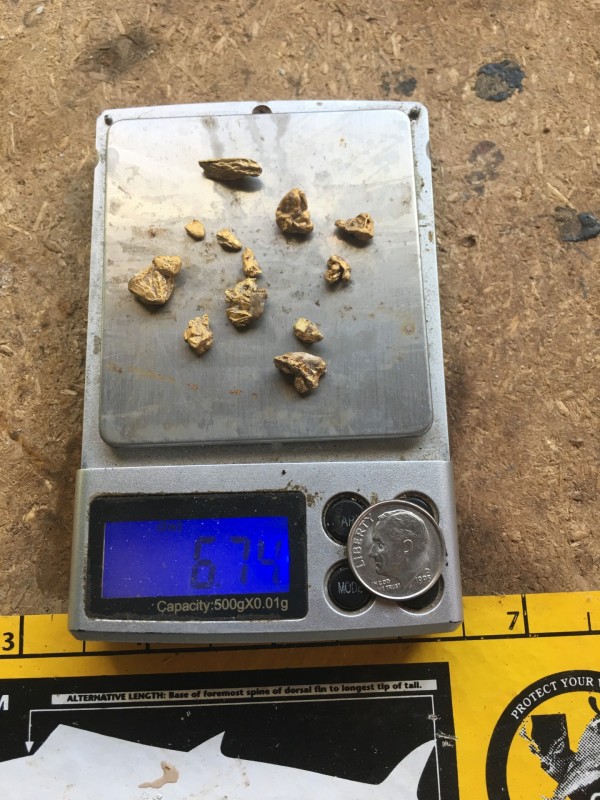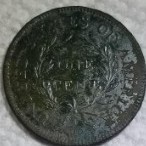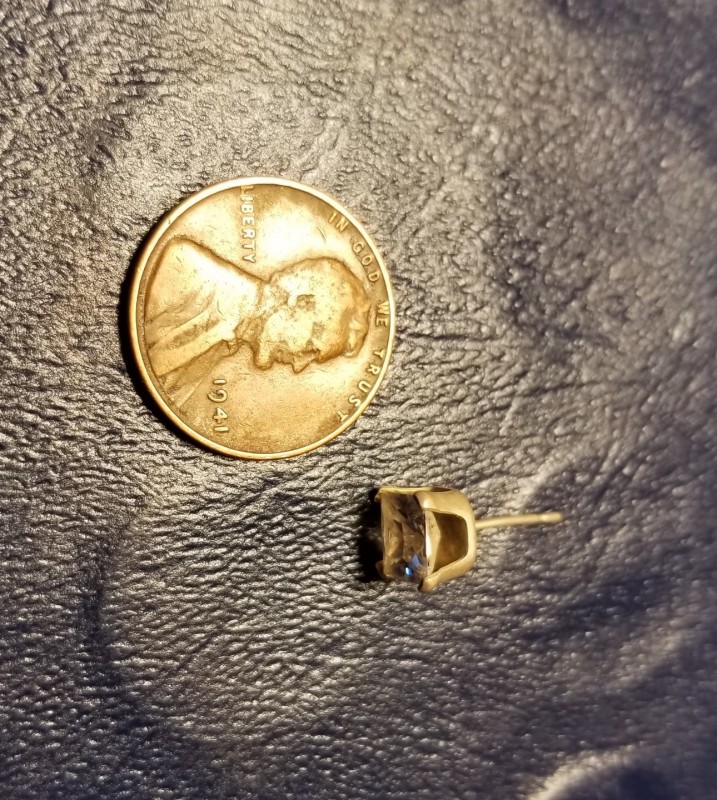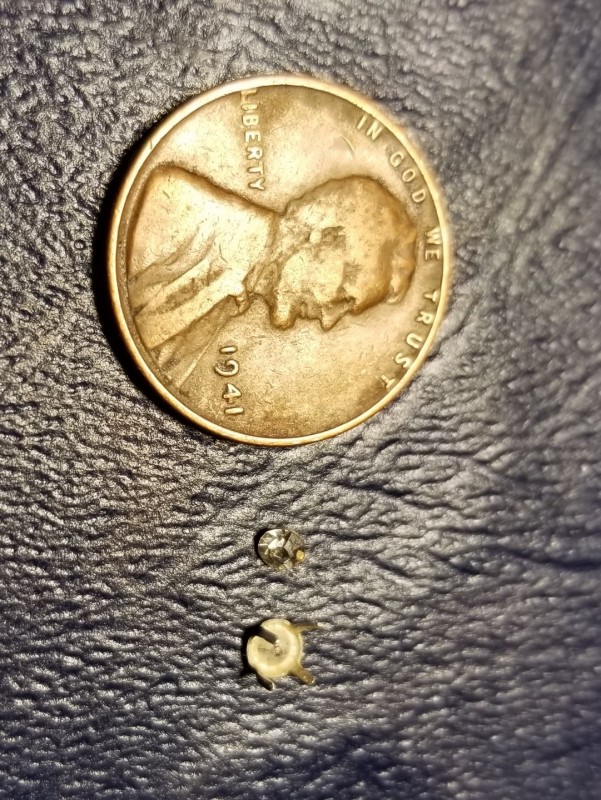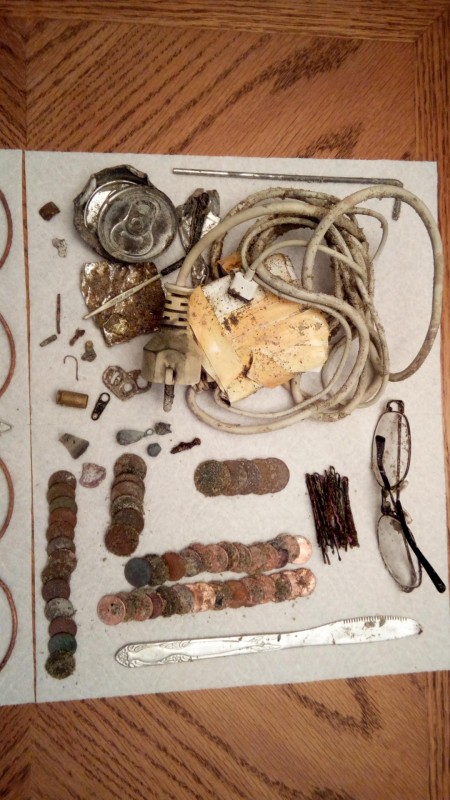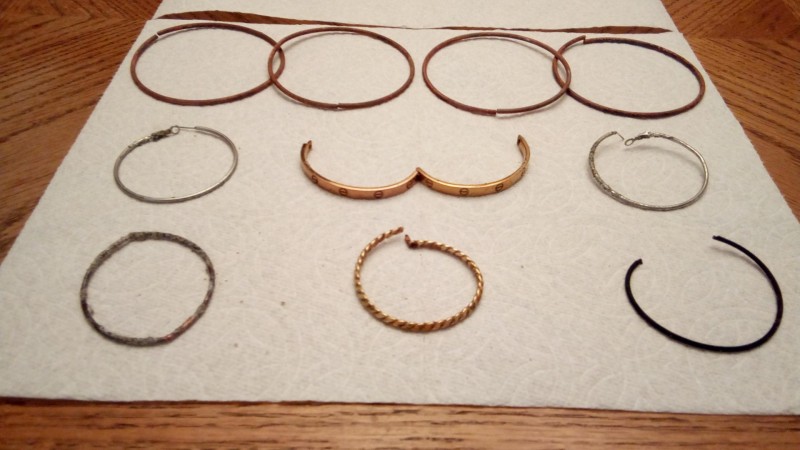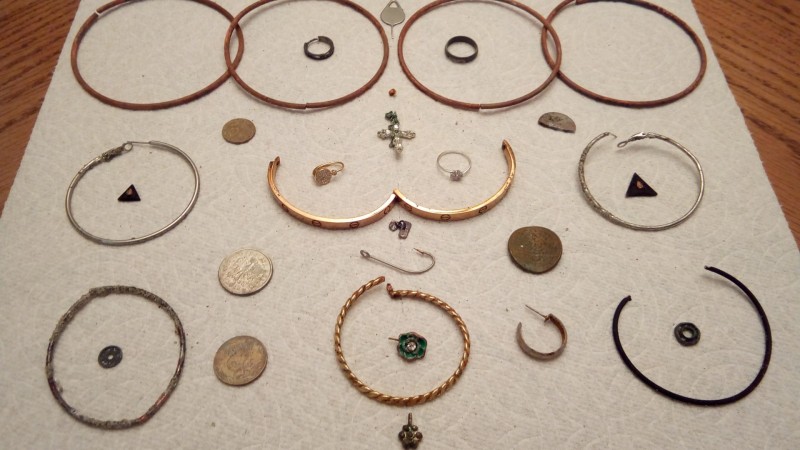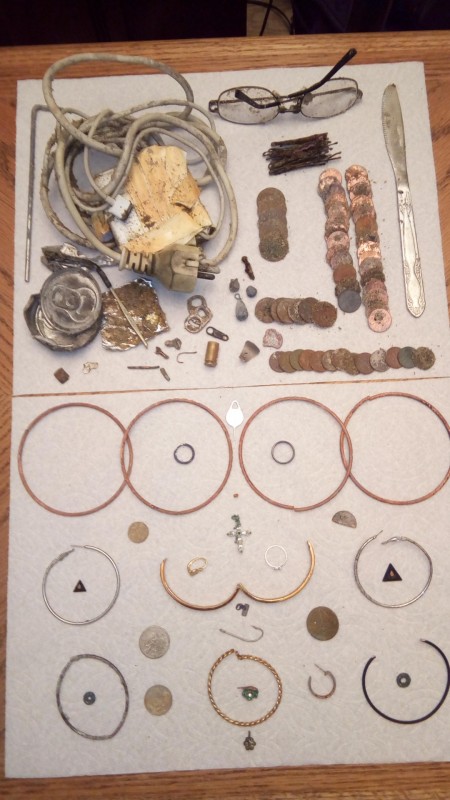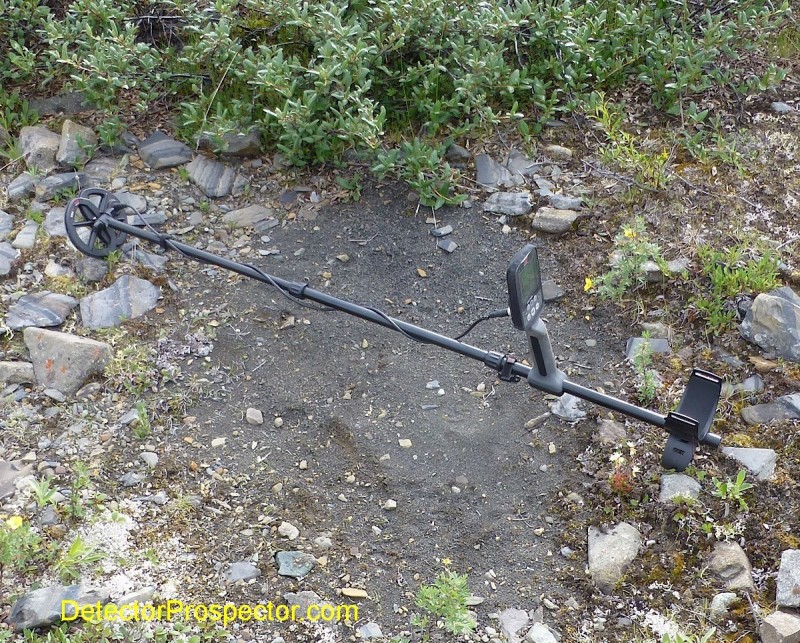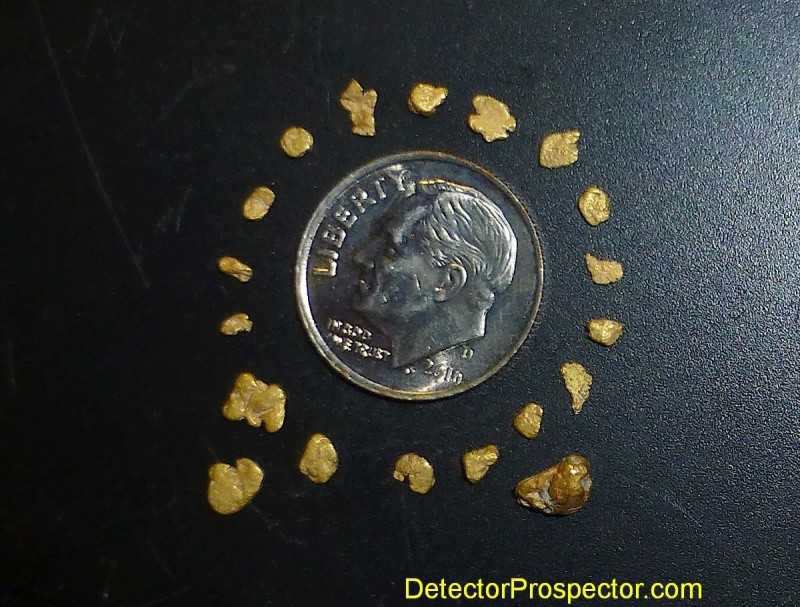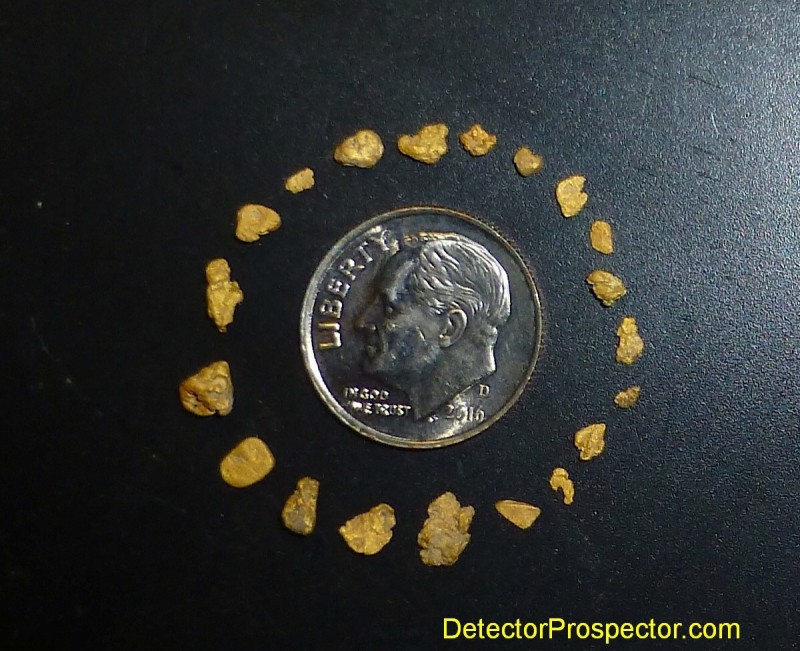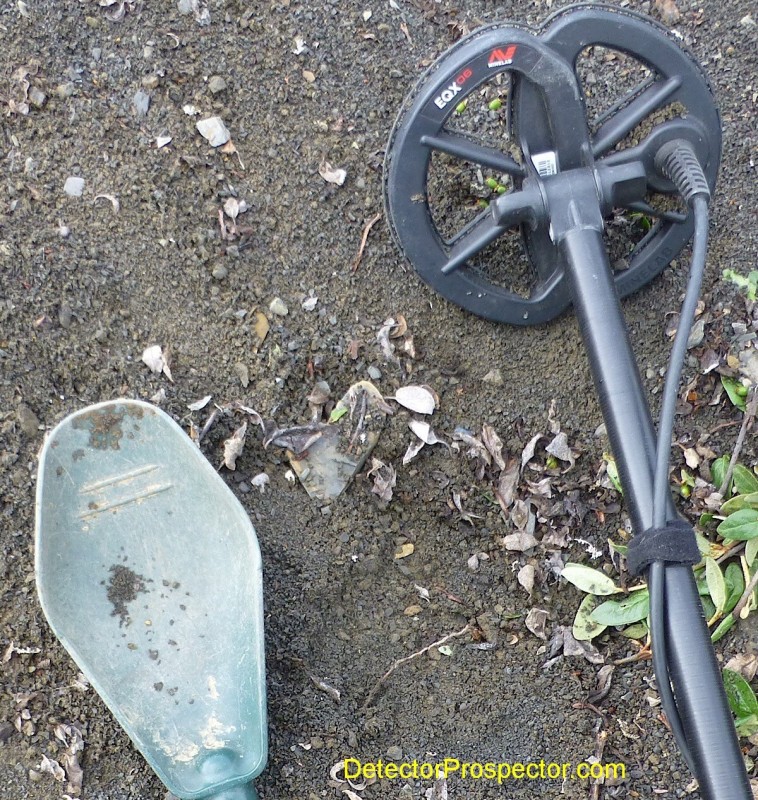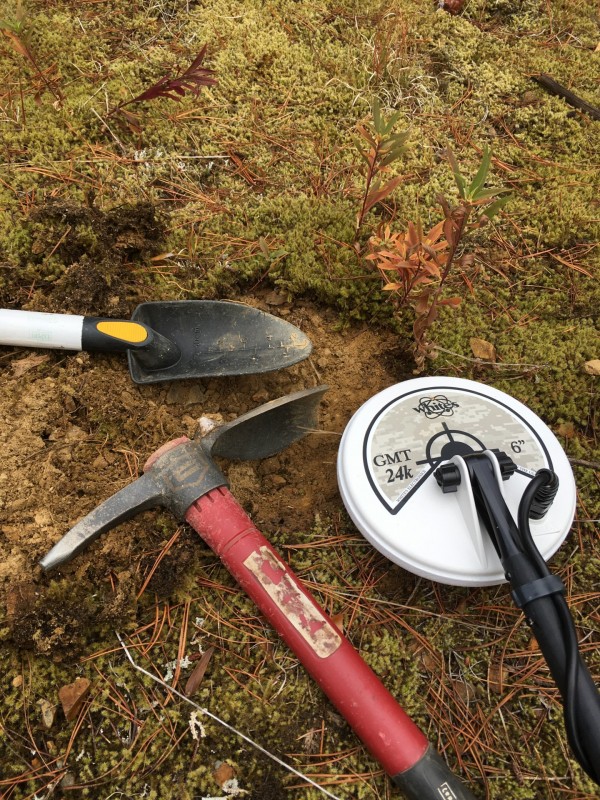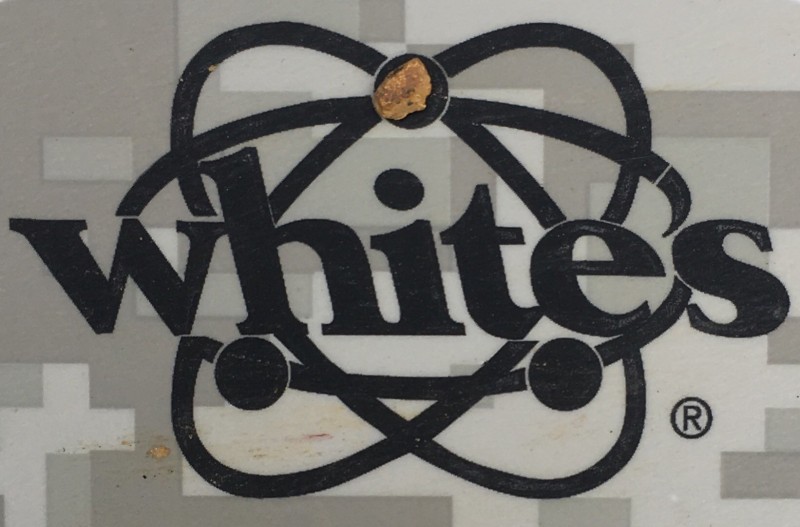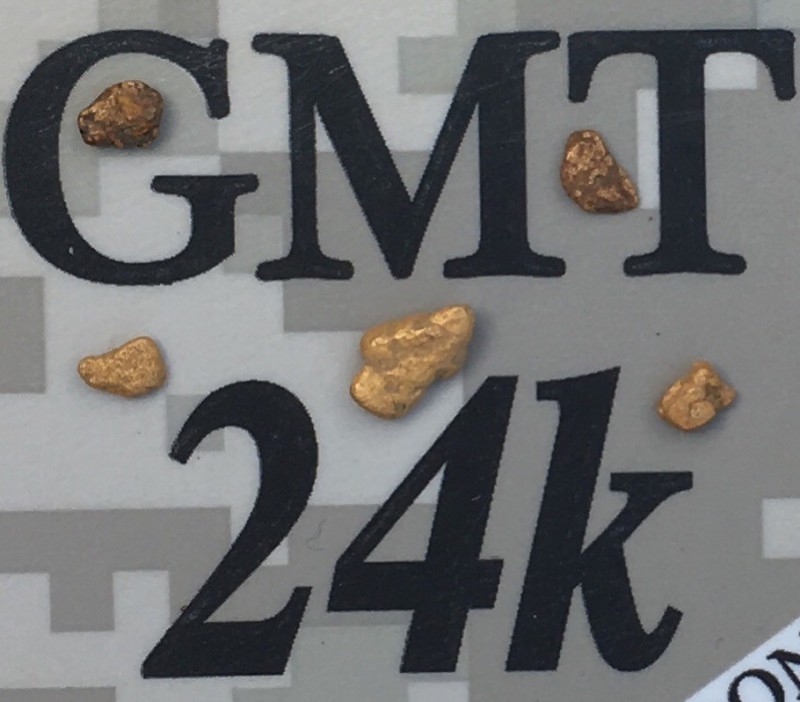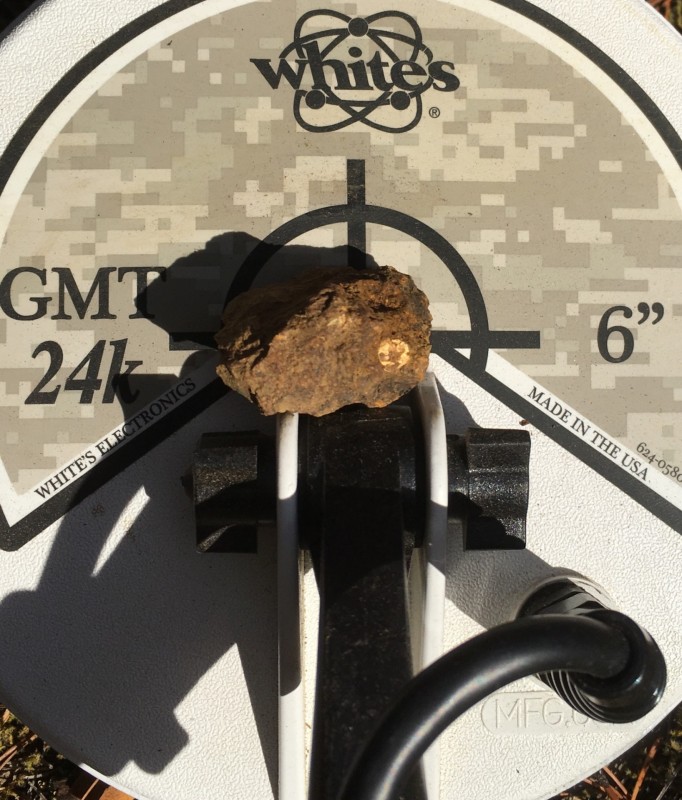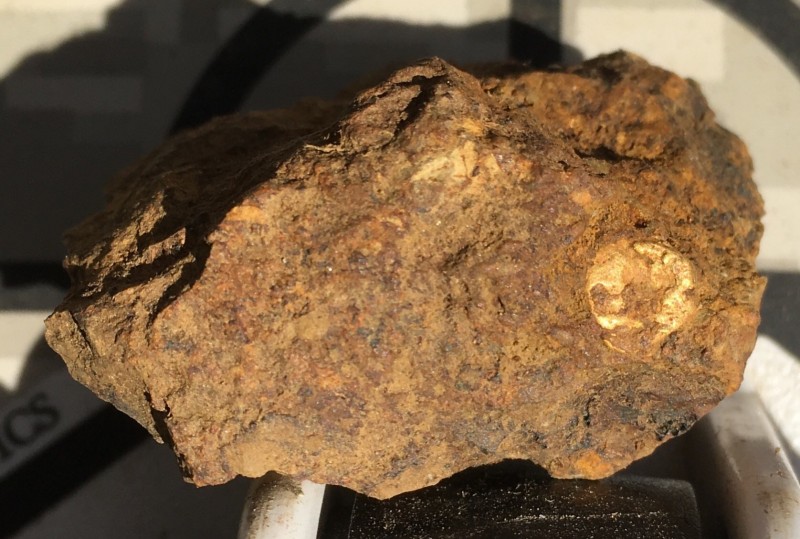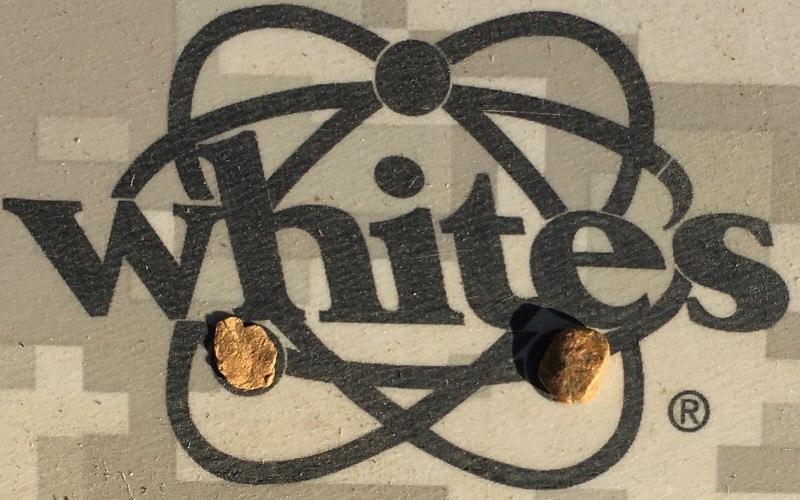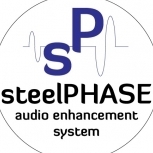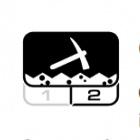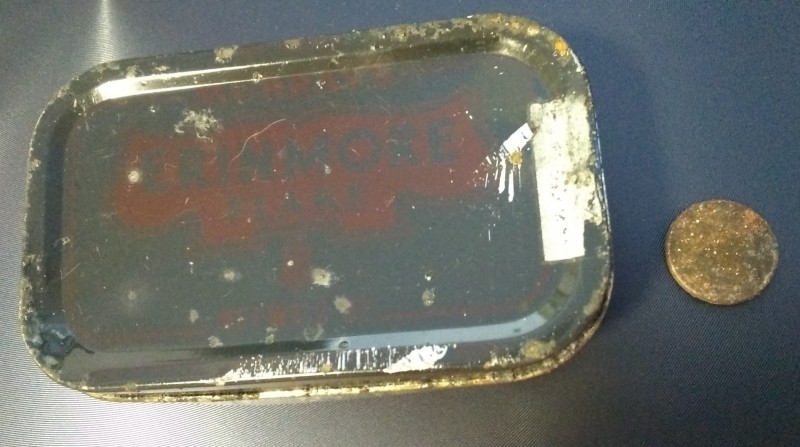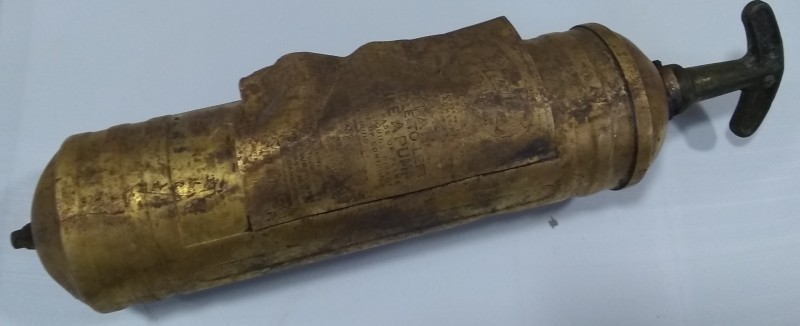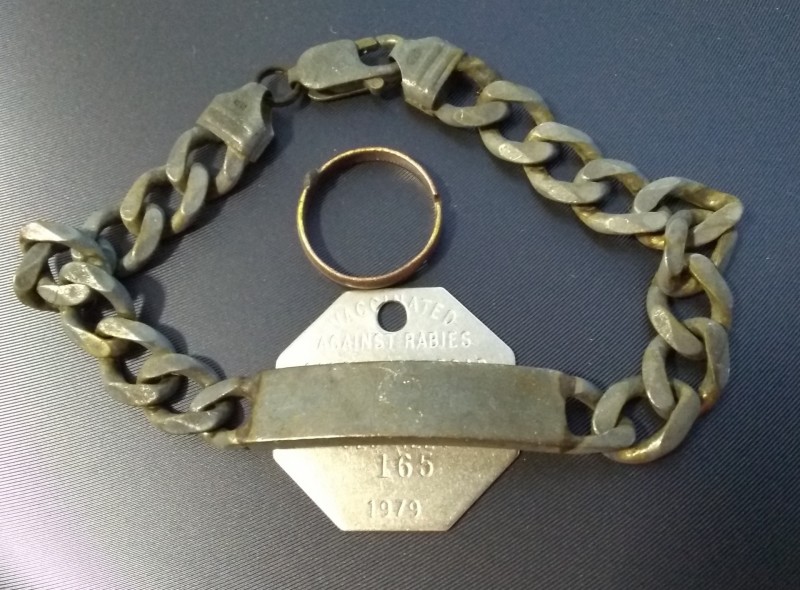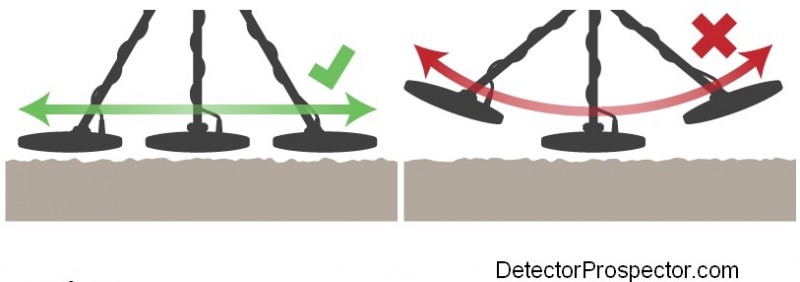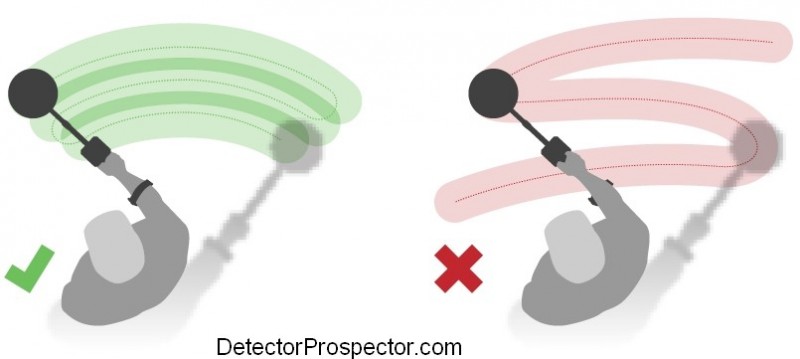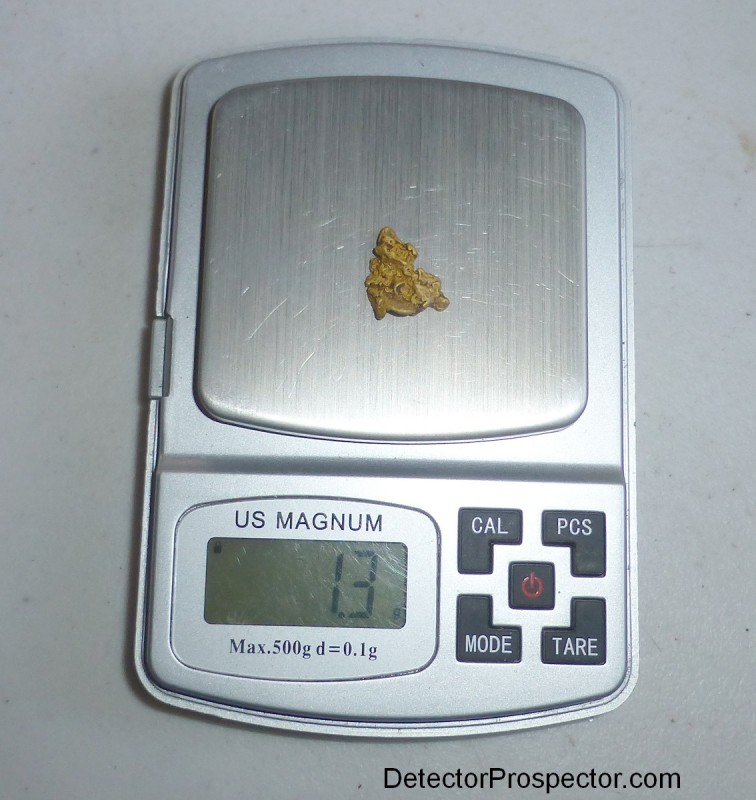Leaderboard
Popular Content
Showing content with the highest reputation on 10/18/2018 in all areas
-
Hi guys, Dave and I had time for a short hunt Sunday. Dave had scoped out a new area that when we got there looked promising. Unfortunately no luck at all. One of these days we will find a new area. I then suggested we head back to a spot that had a bunch of trash, but a lit of mining done in the past. I got lucky and found a couple small pieces in some old drywash tailings. Another piece on a slope, and a 1.2 g nugget in an old hole. Dave went of in a different direction and had no luck...he really needs to pick up his game, he's been slacking lol I've been on the no luck side many times when he has scored. Hunting with Dave is great because if one of us happens on a patch, we'll radio each other to join in on the fun. It all even out in the end. Good karma lol. When I got home I soaked the 4 nuggets in some CLR, and when I took them out there were 5. One was a perfectly formed BB of gold... weird!! I posted before about a quartz specimen I found detecting, decided it wasn't worth keeping as a specimen so I crushed it up, and panned it. It was better than I thought. 7.7 grams. Cheers, Chris6 points
-
That's it, everyone's ground and EMI is different, also hearing ability and preferences, headphones used, or speakers etc etc. there are so many variables. I share my settings because they work for me, and may help others to give them a starting point that has produced results. But yes, users need to play around and find out what works for them, in their spots. I also change my setting combos a bit over time. As you gain experience you tend to experiment a little more, and may find a combo that works in certain situations. Back to the sP01, I like the crispness that Filter 2 gives to the signal, particularly on the SDC, but last time out with it on a flogged patch, I was digging barely breaks in the threshold. On these signals, Filter 1 gave a more recognisable response, due to having a bit more "body" to the signal. I come from an audio background so when it comes to being able to manipulate sound, you can never have too many options in my opinion.6 points
-
Interesting to recover so many religious medals on 1 trip but "Faith" was on our side. The best of the 5 is the yellow gold with diamonds in the middle, but I have to give credit to my brother as he saved that one. The sterling pieces are very nice as is the other ones of lesser metal, but with the same powerful meaning. The TDI Beach Hunter did its job and I have faith this machine will do well for many. Steve, If you feel this post needs to be in the Jewelry Forum, I understand. Some folks do not feel religion wear is jewelry..so I walk softly.5 points
-
On my way to Rye Patch last Thursday morning about 1:17 AM I was on 395 and observed a meteor or 'fireball event' that was just incredible. I now see that there is a video that does not do it justice. Before I put a link to that video and those reports let me tell you what I saw and how I reported it. This is what I saw: About 20 minutes north of Ridgecrest on 395 I had just gotten out of my car. As soon as I opened the door I could see it coming. It was several objects burning in the sky with 6-7 separate streaks. It was a dark night and no moon. It was perfectly clear where I was and I thought I was just looking at a huge screen TV. The height seemed to be that of a commercial jet but this was much larger. It didn't remind me so much of a meteor as it did space junk. I guess we'll find out more about that later. It was just a coincidence that I stop at this particular time and place. I probably would not have seen it or I would not have seen as much of it if I was still in the 4Runner. Most of my report is in the report itself. So, what do you do when you see an 'event' of your own? Well, I drove all night to go looking for some gold at Rye Patch so that is what I did. That night I had to sleep. The next night I had a chance to get on the computer and ask the question 'What was that?' Where do you go, what do you do online to report something? As it turns out you go to REPORT A FIREBALL at the American Meteor Society. https://www.amsmeteors.org/ When you get there you can click on Report a Fireball. You will get asked a series of questions to describe what you saw in a technical way that will let the software develop a map of the event as you and hopefully many others saw it. You can upload pictures and video. You can also search for events from all over the world. So, I reported and I didn't see my report with the others. As it turned out there is a pending report file and if you don't state it as they are compiling it then your report will not be added. I now knew my event number was 4094 so I edited my report and it was added to the 29 others and still counting. It was a very, very neat experience. The video now posted on YouTube is only 1/100th of what I saw. I had better than a front row seat. I was in the middle and there were no heads or clouds in my way! Here is the report link: https://www.amsmeteors.org/members/imo_view/event/2018/4094 Here is the video: https://www.amsmeteors.org/videos/?video_id=1445 Mitchel4 points
-
Years ago, when I started to hunt Rye Patch I knew it was well past it’s hey days! Yet, I continued to see nuggets being found there by others Prospectors! Our group, finally started to pop some gold after wearing out several sets of boots and skid plates on our old trusty GPX’s. With the new generation of Minelab Detectors, SDC 2300 and the GPZ 7000, it was a new game. Having cut our teeth on the learning curve of both new detectors on the California side of the hill, we set our sites to Northern Nevada. Multitude of hours by our group to establish productive ground and techniques with our GPX’s, lead our new detectors to what seemed like brand new patches of gold. This last outing was no different! One of our hunting members had a moment of Total Recall and remembered a few years back that we found a few nuggets in a spot with our old GPX’s. Well we hit the spot swinging and soon our detector’s started to sing back to us! Now remember, I was out there a couple weeks ago, trying to track down a couple new spots for this group hunt trip. I didn’t find any new spots on that trip and we didn’t even hunt the old spots on this trip, which I did good on. Now, there is only one way to run the SDC and that’s turn it on, it’s and incredible detector and the operators of it on this trip pulled teens of nuggets with it. But, you have to know the variable sounds of the SDC when you run the coil over a target that set you apart from others swinging the same machine over the same dirt. It’s the same with the GPZ 7000, you really can’t run it wrong, just turn it on! You make it run for you and your inner self. Sure I have settings, I like and so does everyone in our group of Prospectors. You have to know what it’s telling you if it’s a target or not, there isn’t many Duck nuggets left in any old gold field(s). Air testing or burying a test nugget does not reproduce any of these nugget signals (tones). I’m still learning tones of the GPZ and will never be and expert of them. The sweet tones of a nugget, I do have lock in my mind is what keeps me and boot makers happy! Lucky...No - spend the time in your local gold field, might take a few pairs of boots, skid plates and multitudes of digging holes in hot ground and rocks to learn the tones of your settings of your detector. We had a great time, even though the wind was crazy windy and made Detecting a challenge - Persevere, press on regardless! Until the next hunt Here’s Robin’s and my 2 1/4 day hunt total in dwts3 points
-
I too have found gold on several of GPAA claims. That being said, part of dues the money goes to fight the fight with the bureaucracy to keep public lands open to small scale mining. As a bonus, you get a detailed book of maps with the GPAA claims. Some of the claims may well be worked out, but it will put you in the areas that have gold. Do your own research from there. Norm3 points
-
There is a beach volleyball court near my place. About a month ago, on my way home from another site, it was empty. I had my super six coil on at the time, so I did a walk through the court...not being overly slow or thorough, but more trying to get a feel for the ground balance, how high I could have gain and sensitivity, etc. Found the standard couple coins, but did get two stud earrings. One silver stud with CZ, the other just plated with glass. Not bad, I thought. Here is pic for size. Then, last week, I was going past it again, this time with VGG again, but with the stock 11" pitbull coil. I decided to run it again, and go slower, and listen for deeper items, because it has multiple layers of deep sand. I was thinking deep coins. the only notable item I got was this stone with small setting. Tone was clean and strong. It was only 3 or 4 inches down, but pretty cool. Basically told me unless I am concerned with too many targets under the coil at one time, no reason to take the larger coil off.2 points
-
This was my first beach hunt in a few days because I had been out in the Rye Patch area over the weekend. While I was gone I understand that it had rained and some wave alerts had been sent to my email. Our area beaches get hit hard by detectorists but I know them pretty well and followed my intuition when I got there. We don't have a negative tide right now and there is a Santa Ana wind blowing so the new waves are very small. On my way 'out' I hunted near the waterline. There was very little to find. I walked about a mile or so with very few targets. There was a bit of a trough at the bottom of the hill (beach slope) but nothing seemed to be holding. I was thinking about leaving and I worked back in the direction from where I had come. Then I got a clue. The clue was the junk wire pack. It was completely buried in the wet sand and had a thin plastic bag around it. It certainly is an unusual beach find for me. This pack was at the bottom of the hill and just above it for about 6 feet or so was hard sand and just above that was about 10 yards of 'past wave' deposited sand. You need some energy to move targets and you need the right conditions for those targets to be 'grouped' and deposited. Some beaches will stay this way for a few days and some beaches will only keep targets for a few hours. I look for these pockets. I liken it to a crab crawl on the Deadliest Catch. Anyway, I went up into this area and found a hoop earring among the bobby pins, pennies and a few other coins. I was using the Nox 11 on all metal and I was digging EVERYTHING. Sometimes I skip pennies and bobby pin sounds but not last night. Then I was surprised by one of the silver hoop earrings and its mate was just about 5 feet away. Then came a copper hoop, and then another and all of them within 10 feet. They're all water tarnished. Then I got what I thought was a ring ... earring it turns out but then a stainless steel bracelet. Then another earring (GOLD) and finally a couple of silver rings (.925). I worked the patch with a grid pattern and it kept giving. I had had enough after 4 hours. A 'bad' beach had turned into the most hoops (10) I've ever found. I've been on beaches where I've found 5 chains in a session but they are as rare as this beach. You never know. Follow your clues. Mitchel2 points
-
...in this test I also tested the coins, small and medium size coin,,....50eurocent at a depth of 38cm in the ground, and 1 Polish grosz-15mm -1.65gram coin-at a depth of 29cm.in the ground. and the big coil detects these coins with a good signal, tomorrow it compares to 15x12" coil and 11" standart coil on these coins...2 points
-
Tesoros used to be a very good machine for those hunts. There does seem to be a difference between the blues and Xcal IIs. Sensitivity seems higher with the IIs...... which i dont know is an advantage since you get more flasing and have to turn them down. The Blues dont false much at all. What i have noticed thou they can vary. Ive got some more sensitive... but not as deep and others the other way around. Some switching to Disc from PP dont go nuts like they should..... others do. Also...... in the water...... some you can hunt near others you cant because of the feed back. Repairs seems to be less on the blues as well. But in most cases you have to replace that 700mah battery right off the bat. Some of the Xcal IIs even had a 3rd wire attached to the board going to the phones..... which we could never figure out why.2 points
-
Here is a short underwater hunt I did with the Equinox! 1.5hours of scuba ? https://m.youtube.com/watch?v=dl2jQqYrjjY2 points
-
Just returned from Gold Basin, lots of trash , small stuff but no gold. I was not the first to hunt this area s there was lots of unfilled holes...not as many now...still learning the machine. Most of all , I HAD FUN AND IF THE WIND HAD NOT PICKED UP I might still be there.2 points
-
My china parts have arrived. Not the nicest build, but it works just great - new tumbler version: I've brought my first 5kg of coins (~ 1030 pieces) to the bank today. Only one 1 cent coin not recognized Been out 2-3 times last week - no special finds. Broke trough the 1000€ barrier .. wow... but the beaches are pretty hunted out.2 points
-
Man this bungy is nice! Adjust length easily, at the top or bottom, and is very fast to slap on another detector, very well thought out. Only screwed up one thing Doc, u made them to tough i wont ever need to buy another bungy again, this things gonna last forever.lol2 points
-
Gold Nugget Detecting with the Minelab Equinox Metal detecting for gold nuggets is one of the most difficult detecting tasks, and learning to run a VLF detector in highly mineralized ground will challenge even the best detectorists. There is more to this subject then can be covered in a brief article but I will try and offer some tips to get people started with the Minelab EQUINOX for gold nugget detecting. Minelab Equinox with 6" coil at work gold nugget detecting Tiny nugget in scoop - the Equinox can find very small gold nuggets! The EQUINOX 800 has two modes that are not available on the EQUINOX 600 – Gold Mode 1 and Gold Mode 2. The two Gold Modes as far as I h e been able to determine are identical except for the default settings. Gold Mode 1 is set up with a default Recovery Speed of 6 and Gold Mode 2 is set up with a default Recovery Speed of 4. These modes employ a boosted audio that increases both in volume and pitch as a target is detected. This in turn accentuates the signal on tiny gold nuggets. The threshold is also different than the “reference threshold” employed in the other modes and is more responsive to ground changes, providing important audio feedback about changing ground conditions. The Gold Modes are similar to the threshold based all metal modes available on most VLF nugget detectors with a major difference. A target id number is displayed for strong targets and each target id number can be independently set to accept or reject. In this regard the Gold Modes are a hybrid mode with more discrimination capability than is available in normal threshold based all metal modes. Normal VLF nugget detecting relies on the operator having their ear very tuned into the threshold sound of the detector. Slight variations in the threshold tone can indicate potential targets. The threshold tone is also very sensitive to changes in the ground mineralization. This includes the so-called “hot rocks” which have mineralization different than the ground they reside in which makes the detector react to them as targets. The challenge is to get the detector to operate with a relatively smooth threshold as the coil is swept over the ground so that desired targets will stand out. If hot rocks are signaling with every sweep of the coil, then progress will be extremely slow if not impossible. Tuning a VLF detector to hunt nuggets starts with the theoretical most powerful settings, and then reduces those settings until the detector becomes stable. Every setting is a trade off, because making a detector more sensitive to gold also makes the detector more sensitive to mineralized ground and hot rocks. The key settings for the EQUINOX 800 in Gold Mode are: Frequency. Multi frequency is the default and the most powerful frequency setting, with 40 kHz and 20 kHz single frequency options. Multi is the most sensitive to gold, but also reacts the most to bad ground and hot rocks. The goal is to get the EQUINOX to run well in Multi but if bad ground or hot rocks make that impossible, going first to 40 kHz and then to 20 kHz will make the EQUINOX progressively less reactive to the ground and the hot rocks. Ground Balance. The default is ground tracking on. Tracking attempts to keep up with and smooth out the variations in the ground. In doing so it has a filtering effect and can possibly tune out the slight audio variations that come not just from the ground but from very small or very deep gold. Tracking off is therefore the most sensitive setting, with adjustments made via the Auto (pump) method or manually. Sensitivity. The range is 1 – 25 with a default of 20. Increasing sensitivity increases the audio response from all targets, plus the responses from things like electrical interference. Most importantly, too much sensitivity makes the ground itself into one giant target, and so if the detector refuses to ground balance properly then reducing sensitivity until a proper ground balance can be obtained is critical. The default of 20 can easily be too high for the worst ground, and settings in the mid to low teens may be necessary. Recovery Speed. The range on the EQUINOX 800 is from 1 – 8. The defaults are 6 for Gold Mode 1 and 4 for Gold Mode 2. Recovery speed as regards nugget detecting can be viewed as a smoothing filter. Higher settings act to smooth out audio responses from the ground and hot rocks. Lower settings enhance audio responses from weak gold signals, but also make hot rocks and bad ground stand out more. False signals from the coil bumping a rock also increase at lower settings. In general the EQUINOX will be easier to handle at higher Recovery Speed settings, with more careful coil control required at lower settings. Iron Bias. The range is 0 – 9 with a default of 6 in both Gold Modes. Lower settings reduce the chance of gold being identified as ferrous, while higher settings reduce the chance of ferrous items being misidentified as gold. Accept/Reject. The default is -9 through 0 rejected, 1 through 40 accepted. The discrimination range on the EQUINOX runs all the way into the ground signal, with ground signals in highly mineralized ground normally coming in at -9, -8, and possibly -7 though it depends strictly on the ground itself. Hot rocks can read almost anywhere, even in the positive number range in the mid-teens or elsewhere. Electrical interference is also likely to exhibit in the low negative number range. Any offending numbers including trash targets can be blocked directly, but the more numbers that are blocked or rejected come at a cost of slightly less signal strength on desired targets. Threshold. The range is 1 – 25 with a default of 12. This is normally set to be just loud enough to hear, but no more. Just a barely discernible tone. However, the threshold can also act as a backend filter. Once all other tuning has been completed, the threshold can be set lower until it is silent, or set higher than normal. Running silent can suppress small variations in the ground signal but also the weakest gold signals. Running the threshold higher than normal can smooth out weak variations, again with a subsequent loss on the faintest gold signals. My starting point (initial settings) for either Gold Mode are: Frequency: Multi Ground Balance: Auto (pump method) with manual tweaking Sensitivity: 20 Recovery Speed: 6 Iron Bias: 0 Accept/Reject: -9 through 40 accepted (either through the settings or by hitting the “Horseshoe button”) The main thing I am going to try and do is operate the EQUINOX in Gold Mode without blocking out or rejecting any target id numbers. The goal is to find settings that reduce and smooth out ground responses while reducing the signal from gold as little as possible. These two things fight each other and there are no perfect settings, but simply the best compromise possible. For some people that will mean making the machine very stable, while others may prefer hotter settings that require more audio interpretation from the operator. The first step is to find an area clear of trash, and walk a bit waving the coil over the ground. Chances are you will get lots of ground noise. Go into the settings and adjust the ground balance. This normally means pumping the coil over the ground while holding the accept/reject button (see the manual) until the ground response evens out. If the ground is highly variable with mixed hot rocks, waving the coil from side to side may work better than pumping the coil. With any luck the machine will settle right down. However, in bad ground it will not, and the solution normally will be to lower the sensitivity setting. Basically this just takes some experimentation, lowering the sensitivity and adjusting the ground balance until the detector reacts very little or not at all to being waved over the ground. If you can get the EQUINOX set to where no target id numbers are popping up at all as the coil passes over the ground but where you can still hear faint variations in the ground, you are there. Then it is simply a matter of going detecting, and digging every target that stands out above the faint ground variations present in the threshold tone. Gold can read anywhere from negative numbers all the way up into the 30’s so typical nugget detecting involves digging everything. However, most nuggets weighing under 1/10th gram will give a target id number of 1 or 2, nuggets under a gram in the single digits, and several gram nuggets reading in the teens and higher. The smallest or the deepest large nuggets will produce no target id number at all, just a variation in the threshold. In real bad ground you may have to not only reduce the sensitivity setting, but possibly even increase the recovery speed setting to 7 or 8. In ground that refuses to behave, switching to first 40 kHz and then 20 kHz will progressively detune the EQUINOX , making it easier to get a stable ground balance. Engaging ground tracking may also help smooth out the worst ground – you have to experiment. In severe ground all this may not work, with ground signals still coming in around the low negative numbers and possibly higher. Some hot rocks may read as positive numbers. This is where the EQUINOX can go to the next level. Go into the settings and reject or “notch out” the worst offending target id numbers. This will usually be -9, -8, and -7 but may include even higher numbers, including positive numbers. Block as few numbers as you can. Simply rejecting the bottom three negative numbers will usually settle the machine down a lot, especially if there is any residual electrical interference being encountered. Rejecting target id numbers does come at a cost in reduced signal strength on desired targets, but you may find now that the sensitivity level can be increased from one to several points, reclaiming that lost sensitivity. In theory if you can get the EQUINOX running stable with no target id numbers rejected you have the ideal situation. However, EQUINOX allowing some offending signals to be rejected with an attendant increase in the sensitivity setting may be the better way to go. It just depends on the situation. So far we have been trying to deal with bad ground by using various detuning methods. In low mineral ground you can go the other direction. If the detector ground balances immediately with a sensitivity setting of 20, then try higher settings. You can also try reducing the recovery speed setting from 6 to 5 or 4 or even lower. Each reduction of the recovery speed setting is fairly dramatic and you will find it suddenly very hard to get and hold a decent ground balance if you go too low with the setting. In mild ground however it can add substantially to the signal strength of the weakest targets. Finally, for the worst ground and for EQUINOX 600 owners we have other alternatives. There is no reason at all why the other modes cannot be used to nugget hunt. Park 2 and Field 2 are both very hot on small targets and offer the ability to use tones while nugget hunting. Prospectors who encounter salt lakes/salt flat situations would do well to remember the Beach modes as possible last ditch settings. Either Park 2 or Field 2 can make for very good nugget hunting modes. I prefer to use Park 2 as a base because by default Field 2 blocks out or rejects the key target id numbers 1 and 2. Small gold nuggets read there, so using Park 2 makes sure somebody will not accidentally reject nuggets in that range. You can use Field 2, but beware those blocked numbers and adjust accordingly. For Park Mode 2: Frequency: Multi Ground Balance: Auto (Ground pump method with manual tweaking) Sensitivity: 16 – 25 Recovery Speed 800: 4 - 6 (default is 6) Recovery Speed 600: 2 - 3 (default is 3) Iron Bias: 0 Accept/Reject: Everything accepted, rely on tones (alternative reject -9, -8, and -7 if too much ground feedback) I have suggested accepting everything, and then using the two tone mode to hunt by ear. If trash is minimal then set the tone break lower than normal, so that 0 and several negative numbers read as non-ferrous. This way you can have ground signals reading as low tones (and possibly at a lower volume) and signals from gold as higher tones. Again, this works well with both EQUINOX models. To sum up, I suggest trying to use the EQUINOX 800 in the Gold Modes with no target id numbers rejected. Tune up just like any normal nugget hunting detector, and dig all decent audio signals. Some nuggets may deliver a negative number response or no number at all. A secondary method for more difficult ground is to reject or block out offending ground and hot rock signals. And a third method for both EQUINOX 800 and 600 owners involves using the Park 2 mode as a nugget hunting mode. That should give people plenty to experiment with. Nugget detecting can be very challenging, but learning to do so means you will learn how to wring every bit of performance possible out of your EQUINOX , and that can benefit you in other areas of detecting as well. Good luck! Steve Herschbach DetectorProspector.com Earlier post on same subject Gold found in Alaska by Steve with Minelab Equinox Gold found in California and Nevada with Minelab Equinox1 point
-
The BB is possibly a spatter ball from a crucible used to check purity of an ore sample. I have found a number of BB's on the walls of these crucibles thrown behind the sampling lab. The crucibles were only used once and then thrown away. Often the lab guy would miss the spatters up on the sides-sometimes hidden by the flux. Good find Chris.1 point
-
Way to score; that BB is awesome, a perfect sphere of gold. Nice hunting.1 point
-
That same scenario has netted me some nice finds as well. Good job and congrats on the V1 point
-
1 point
-
Way cool! Most don’t get the opportunity to witness an event like that their entire lifetime. Thanks for posting Mitchel.1 point
-
I'm still wavering. Now I think I will be prudent and stay at 19. Sigh.1 point
-
Boy, I did not realize this little find would generate such a Buzz. Now I need to go to the store and get another bag of munchies and come back to read some more. If anyone else has found such interesting devices you are welcome to post, but don't do it on a weekend, as my local mini mart usually runs out of Cheetos. Thanks for all the interesting comments.1 point
-
Great information. For years I've wanted to take the time with a small coil, find and mark what I believe to be good targets, then switch to the stock coil and see what I get. That would be very interesting to say the least.1 point
-
I took the new GM24K into the hills this past weekend for its maiden nugget hunt. Although my first time out with it was actually a week prior, it really wasn’t a hunt since I was mainly just familiarizing myself with the features and functionality of the machine and trying out different settings on a small buried test nugget. But after finally getting the 24k dialed in, I did happen to find a subgrainer a mere foot away from the test nugget that day; an obvious zippy target at an inch and a half deep.? This little yellow speck won’t even register on my grain scale! So fast forward to Saturday: I was digging every target or nuance of a target and noting the VID numbers. The occasional hot rocks in the area seemed to lock in at a solid 1 or 2 on the display screen, without deviation, but even the smallest of the subgrain nuggets I found would bounce around into higher registers, sometimes in the 70s or 80s, making it easy to differentiate the gold from the hot rocks. Slow and careful searching yielded 5 of the little yellow blighters. Sunday I continued on where I left off on Saturday, and although I was finding tiny bits of foil and lead, the gold eluded me all day until just an hour before quitting time. I was in a trashy area littered with small remnants of old timers boot tacks that just screamed on the 24k; they were shallow enough so that a quick dig and poke with the super magnet took care of them. One of the screamers however stood out from the others because it was reading much higher on the VID. First thought was something sizeable like a 22 bullet or casing, but it turned out to be a chunk of bedrock. A quick rinse with water revealed it was actually lithified ancient riverbed sediment containing a partially exposed nugget.? Definitely a nice surprise. The 24k sniffed out a couple of subgrainers nearby to round out the day. I’m really liking the new Goldmaster 24k, a very versatile VLF gold machine with innovative ground balancing technology. It’s lightweight, well balanced, very stable at high sensitivity with minimal coil bump falsing, has a pleasant tone, and won’t easily tip over when sitting on the ground. Good work, White’s! ?1 point
-
1 point
-
Wow, when I first joined it was $65 for 3 years, didn't know it had gone up that much. I joined LDMA just a month or so ago. I have found gold at the Gold Basin claim and at the Stanton claim but I can't say it's worth $90 for a year. You would have to visit a few claims to make it worth while. Good luck what ever you decide.1 point
-
I'll never write Rye Patch off, as I have fond memories and many stories of Success for customers and myself back in the day. In fact, I still enjoy offering Field Training there as the few pieces of gold the new customers recover are well earned. The folks who think they can go out there and clean house, missed the boat by at least 10 years. But even today (just as you said) the newer GPZ and SDC technologies are winners and good gold can be dug up. My last year hunt produced 43 nuggets with the trusty Zed from Rye Patch proper and some of my customers just found a few more 2 weeks ago. Yes the new technologies will allow old patches to give that soft golden feeling again in the palm of the hand. The up and coming GPZ-7500 with small 8" coil will get a few more and the GPZ-8000 with Disc Mode will certainly open up some of the trashy sites. I can't wait to get my hands on those 2019 new models...if they ever make them? Those are fine chunks you and the Mrs found and a few with Chevron patterns too. Words well spoken Lundy and thanks for sharing.1 point
-
While I can’t speak for Steve in Idaho, I’m certain I simply didn’t hit that spot with the Monster. The fact that the rock was a shallow screamer takes all the other variables out of the picture...any hot VLF nugget detector would’ve totally banged it, regardless of coil size, sensitivity, etc. I'm really liking the 24k because of what you said there, Kiwi; good point.1 point
-
I prefer the small coil on the 24K for tiny bits and specimens. It is a fine machine and I give White's a big thumbs up on this one. Good luck to you.1 point
-
Hey JP No offense taken and no magic either. I fully respect you as a prospector and would love to do a training day with you. My electronics background is working with, repairing and designing audio electronics so I know by using a form of audio compression you can put an edge on any signal. Although its labeled 'filter' it doesn't really filter as such. It selects a band of frequencies to compress. Unfortunately I should have called it 'mode' rather than filter, but it is what it is. It is primarily designed for headphone use as I feel with using speakers I lose a little sensitivity due to background noise. The B&Z would be as good (maybe even a little louder) when using speakers. Be great to catch up one day in person regards Pat1 point
-
I'd be very interested to read how the sP booster manages to magically do that? No offence Pat but this kind of rhetoric seems more akin to devining with a forky stick than amplified audio. Folks because I make a competing product I've kept away from this type of discussion, at the end of the day they are all audio amplifiers. A good one increases the loudness of the audio with minimal distortion and clipping giving the user a finer resolution of control via the volume pot. The volume control on the Minelab units are very coarse, once you get above certain point they clip, a good booster helps a lot to avoid this. I have a sP booster and it has a nice mellow sound but is heavily filtered, I've used it with headphones and speakers and preferred it for headphone use. I'm not a fan of the aluminium box because the GPZ can smack it at a great distance, but all in all it's a really nice booster. Steve I know this post is a little inflammatory but felt it needed to be said, especially on here. JP1 point
-
With the TDI “floater” properly launched, it’s maybe time to throw out a tidbit on the Manta. I had a BHID - with the 12” coil - boy that baby could float, coil and all. I am now convinced that when the new Fisher PI appears it might be called most any thing - anything but “Manta”. Fisher clearly wants it to be the start of a new PI line and will likely choose a name that suits them. It is moving towards production - the whole “Euroteam” was in El Paso a couple of weeks ago for a “junta” (meeting in El Paso-ese). I have been watching the French beach test dozens of times and I just got the OK to share this. It’s the Beach test video for the manta with the addition of my English captions (upper left of the screen). It helps keep up with the action - assuming you don’t enderstand LE JAG’s French. That is LE JAG - chief tester for the Manta project for the last several years - by the way, in the video.It’s on my Dropbox account, set to share. Just click on the link and it will stream, just like as if it was on YouTube.If I can get organized to do it, I may edit the video down to short clip demos of various key points of the Manta’s operations - we’ll see.https://www.dropbox.com/s/yjfb1ah42fyhvmt/10-10-2%20Manta%20Titles.mp4?dl=0 As the project progresses, there will no doubt be a whole series of demo and how-to videos produced - some in French and some in English. The market for this thing is world wide - Maybe multi lingual versions - pick your soundtrack - who knows. LE JAG emailed me today - his weekend at the beach with the latest prototype netted 23 grams of 18K - the same tally as his last trip two weeks ago. France next summer anybody? Maybe I should get up a tour ?1 point
-
Today I went to another spot. I went here in particular because this place owes me some gold lol. It started off tough, it's really not that big of an area and it was almost full of soft sand on the move. There was some sand starting to pile up though, so I thought I would stick around and look for some low spots. There is a river that drains dark organic material into this area, the wind held it against the shore so the visibility was essentially zero, I had to walk around to find any low spots. The first important indicator target was a dog tag from 1979. This is a little different then a coin in the sense that the dog tag had to have been lost around 1979 or shortly after. A few minutes later I had my first pice of jewelry, a copper ring. I got my first cache today. I've found many coins, many bits of of tin, but never a coin in a tin. It's a "Murrays Erinmore" flake tobacco tin with a Zincoln in it. I know you're jealous. The tobacco tin rang up in the 30s, not long after I got a couple more 30s side by side, turned out to be a fairly hefty one ounce sterling silver bracelet. Nice blue tarnish. Yoink. After that, i got another good hit in the 30s. This one was a big target but the numbers were good, it's fairly easy to avoid iron using the Gold 2 mode, so what the heck lets just see what all the racket is about....a antique fire extinguisher at almost 18 inches. You know how sometimes you leave a huge deep target thinking it sounded like a high conductor, well I guess sometimes they are. This site has quite the eclectic finds. I have to be careful about being too greedy, this place can fill my pouch with junk in no time lol. It's full of soup can rings, caps etc. so I have to focus on coin sized objects and unfortunately blow off some of the single digits on account of excessive foil and fly-by-foil.1 point
-
Sent my MX Sport in for repair, rear plastic housing cracked. I had taped it together to use it in the Rye Patch nugget shoot,(worked fine, and I found a token:)) Whites sent me a new one, even came with new headphones! That's one of the reasons I have two Whites machines. Thank you again Whites.1 point
-
"Dig and you shall receive" Rule #1 in the detectorists bible strick1 point
-
Simon, people think it is a function of the Equinox having a 50 target id range but it is nothing of the sort. I do things like keep all my trash while digging all non-ferrous. Then make piles of trash/treasure based on target id. So I have a White’s V3i with 195 target id numbers -95 to +95. Ferrous is negative so that is 95 non-ferrous numbers versus 40 for Equinox. Over twice as many. So when you do that do pull tabs now magically come up as different numbers than rings? No. Lets say for yucks that pull tabs read 10 - 19 on the Equinox. That would be close to the 20 - 44 range on the V3i. If I take 100 pull tabs that fall in that range and test them, I get 10 piles with the Equinox. The V3i will have 25 piles with fewer tabs in each pile. Ten rings tested are going to end up in several of the ten Equinox piles, and they will also end up in the 25 V3i piles. So if I am digging one particular ring with one target id then I will dig fewer tabs with the V3i to get that ring. But here is the catch. You do not know what rings you will dig ahead of time. All you know for this example is that all the test tabs and rings will appear at 10 - 19 on the Equinox and 20 - 44 on the V3i. Now, since you don’t know the target id for those ten rings, tell me which numbers you will reject on the V3i that will reject the tabs but get the rings. You can’t do it because you don’t know the target numbers for the rings, and there is a ring made for every target number. The only way to for sure get all ten rings is to dig all 10 - 19 signals with the Equinox and all 20 - 44 targets with the V3i. You get all the rings, and both machines will hit the same tabs. Adding target id numbers does not really help much because we rarely dig single target id numbers but instead we dig ranges of numbers. Now, with the V3i and time I can discover that certain tabs bunch at certain target id numbers. The V3i does allow more selectivity and so if I discover one particularly prevalent tab I can reject it with lower odds of missing a ring than if I reject one target number on the Equinox, since each Equinox number covers more items under one number. An expert hunter can use statistical odds better with a detector that has more range rather than less, but it is still a form of educated guess based gambling. Leaving any non-ferrous items in the ground will always come with the risk of desired items missed, end of story. Trash & Treasure - And More Trash!1 point
-
I did not have a GMT to compare directly, and so can’t answer that question with any degree of confidence. Things get real hair splitting when detecting 1/10th grain nuggets. I still know people who think the Goldmaster 3 is better than the GMT. I have been getting lots of messages from people who seem to think I have secret private information regarding which over 30 kHz detector is best. The truth is not much has changed since the 50 kHz Goldmaster II came out around 1990. I can drag a half dozen of these “over 30 kHz” nugget detectors out and spend hours trying to figure out which one I like best. They basically all get the job done, and none so well as to make the others not worth consideration. It very much does boil down to what feels best on my arm and sounds best to my ear. Most importantly, which machine is best depends a lot on the exact mix of ground, hot rocks, size and type of gold, the amount of trash, and level of operator expertise. This being true I might prefer one model at one location, and a different one someplace else. This is actually almost guaranteed. I just don’t see how anyone can make decisions like this based on anything other than getting and using the detectors in question. Sure, I could pick one for you, but you might hate it for reasons that matter not at all to me. I think the 24K is a fine machine but my gut feeling based on memory is no, it does not automatically blow the GMT away. It’s just different, that’s all, and I have no idea whether a die hard GMT user would consider this an upgrade or not. From my perspective going from one 48 kHz detector to another 48 kHz detector is a side step. To really add capability you need machines to be as different as possible, not the same as possible. Will switching from a GMT to a 24K make a giant difference in gold getting capability? Not really. Would adding a TDI SL to a GMT extend a prospectors capability in a significant way? Much more likely. So if I was going nugget detecting tomorrow and had to pick one, the GMT or 24K, which would it be? I honestly do not have a preference. I tend to trust the GMT more as being the “old reliable” but I did like the concentric on the 24K. Yet I have never used that coil on the GMT and it might do just as well. Gun to head I would probably go with the 24K just because it’s new and I do like the new toys. But if a GMT owner gets a 24K and says they prefer the GMT I am not going to argue with them either. If I can barely decide which machine of four I like best when they are sitting in front of me then I have to really, really sympathize with those trying to make these decisions just based on reading reviews.1 point
-
Another of your inspiring and well written articles of real field use and expert knowledge. The NOX is one of those machines that comes along once in most detectorists short carriers. Some folks are fortunate to see 2 or 3 said machines, but that is about it. The overall capabilities and uses of 1 detector under $1000 just buckles me knees ...and I love it. The 1st month I was selling these units (200+ so far), I would have not said it is a true Gold Prospecting VLF detector, but boy I can say that it most certainly is and even better than some of the other Gold Prospecting Detectors out there. I had it in my mind as a Multi Purpose (pretty good at each style of hunting) machine. I can't wait for the comparable models of the other manufactures to come out so we have even more options. Your writing skill is as good as your detecting Steve and that is very rare in this industry.1 point
-
I mostly mean walking very slowly. The swing rate depends on the recovery speed, etc. Usually quite slow but there is such a thing as too slow. You have to experiment with a target to find the sweep speed that works best. But I mean being far slower and far more methodical than what you are doing. It just depends on what you are doing because ground coverage does count. For that I am walking at a normal rate and swinging at a normal rate. But for "killing" a small patch of ground, sanitizing it of all targets, you have to really slow down and work hard on the whispers. From Equinox Manual page 16: Sweeping the Coil EQUINOX Series detectors are motion detectors, meaning that the coil must be moving across the ground in order to detect a target. If the coil is held stationary over a target, it will not be detected. The side-to-side detecting motion is called 'sweeping' or 'swinging', and with practice will become a comfortable and fast way to cover ground. Sweeping the coil incorrectly can cause you to miss targets or can generate false signals. Though the coil assembly is rigid and durable, sudden jolts or bangs may cause random signals and inaccurate Target IDs, as well as excessive wear and tear. Careful sweeping will ensure the coil performs to an optimum level at all times. Sweep Parallel to the Ground You will obtain the best performance when the coil is swept close and parallel to the ground at all times. This will maximise detection depth and improve the response to small objects. Avoid excessive brushing of the coil on the ground. Overlap Your Sweep Practice sweeping the coil over the ground in a side-to-side motion while slowly walking forward at the end of each sweep. Slightly overlap the previous sweep to ensure full ground coverage. An average sweep speed is 2 to 3 seconds from right-to-left-to-right. More on the above. Classic patch vacuuming techniques also call for hitting a location from multiple different directions. Nuggets can easily signal when swept from one direction and not another. Best practice involves hunting from four different directions. The fact is that the smaller the gold nuggets get, the more plentiful they are. That means I have places where I know there is small gold, and I can almost 100% of the time go back to them and find more gold by employing ever tighter control and patience. It is a game of inches or fractions of inches, such that simply removing any rubble or sticks etc. will usually reveal more gold. Most of my detector nugget testing involves going back to an old patch and just working harder than the last time. Not working harder physically, just concentrating harder and being tuned to the hilt and practicing the best coil control I can manage. And being willing to run hot and dig lots of little hot rocks or borderline wire bits if that is what it takes.1 point
-
A note on Recovery Speed. The basic story is lower Recovery Speed settings draw out and elongate/enhance all audio signals. In low mineral ground and sparse targets you can in general say lower is better. In areas with electrical interference lower Recovery Speed settings tend to reduce EMI "chatter". However, the detector gets touchy in bad ground at lower Recovery Speed settings. Ground response is magnified as well as responses from hot rocks. If the Recovery Speed setting is too low the detector will not even want to ground balance on bad ground. Hot rocks will react more strongly at low Recovery Speeds, and can act to mask adjacent gold nuggets, just like a coin can be masked by a piece of trash in a park. Trash items like nails can obviously act to mask nuggets also, and so low Recovery Speeds will enhance nugget masking in trashy locations. Coil knock sensitivity is enhanced by low Recovery Speed settings. This is a problem in particular with the stock 11" coil, not so much with the 6" coil. If the coil seems overly sensitive to being bumped against things, increasing the Recovery Speed will help alleviate this. Which all gets back to that the simple out of context "lower Recovery Speed equals more depth" is an incredibly misleading statement. It is just as accurate to say that higher Recovery Speeds can reveal targets missed by lower Recovery Speeds. If a lower Recovery Speed results in a missed target due to masking, how exactly is that "going deeper"? Anyway, long story short is if you look at a lot of my earlier writing I tend to fight back hard on this idea of "lower Recovery Speed equals more depth", especially as regards nugget detecting with the 11" coil and knock sensitivity. With the 6" coil out now I am lightening up on this because the benefits of lower Recovery Speed are immediately obvious with the 6" coil and on tiny gold in particular. For covering ground I still lean to the higher Recovery Speed setting, but when down and dirty hunting a 20 square foot patch with the 6” coil at a snails crawl low Recovery Speeds can really enhance tiny targets.1 point
-
Thank you everyone. This should not be read as the be all end all of nugget detecting with the Equinox. It is a very powerful and subtle metal detector, and so everything I wrote is just a good beginning. I am still learning little things with each new outing to new locations. One thing I think I am seeing is that Multi has built in ground canceling capability not available with single frequency detectors. It has been well noted that for many locations and regular detecting you do not need to ground balance the Equinox at all. This is because the multifrequency processing is doing a lot of the work up front and so the ground balancing procedure only need take place in extreme ground. This exhibits when nugget detecting in that hot single frequency detectors have a very touchy ground balance setting. A Gold Bug 2 for instance, you have to deal with very fine ground balance adjustments. Just a hair off in either direction, and the detector reacts very strongly to the ground. The Equinox by comparison seems to be able to fudge the setting with less dramatic negative results. This can be very handy when dealing with hot rocks. The last location I worked was northern Nevada, mildly alkali (salt) type ground. The Equinox with small coil and sensitivity 17 wanted to ground balance at 6 to make the ground not react at all. However, at this setting there were reddish rocks containing maghemite that were giving positive signals. Maghemite is one of the nastiest minerals a detector has to deal with. From Advanced Nugget Hunting With the Fisher Gold Bug Metal Detector by Pieter Heydelaar & David Johnson, page 33: ”Maghemite is gamma ferric oxide. It is red or reddish brown in color, and usually has an earthy texture. It commonly occurs in rocks that have been chemically altered by fire (forest fires, camp fires, etc.) or weathering, and in red or red brown soils. Some tropical or sub-tropical clays may contain more than 10% maghemite and may be so magnetic they will be drawn to a magnet. In many gold prospecting areas, “hot rocks”, which are of ordinary appearance but sound like gold, owe their obnoxious behavior to their maghemite content.” I played with one of these hot rocks a little. The rock went quiet at ground balance setting of 0 but now the ground was reactive. I settled at a ground balance setting of 2, which still kept the rocks quiet while still allowing for quiet operation over the ground. You can play these ground balance offset tricks with single frequency detectors, but it is much harder to get it right. Multifrequency seems to allow for more slop in the ground balance setting without the immediate negative aspects seen with most single frequency models. I have been using my Equinox in preference to my Gold Monster purely due to all the adjustability. The problem can be too much adjustability for many people. The Gold Monster basically gets the job done with almost no tuning expertise required at all. The Equinox has impressive capability also, but favors people like me that want full control over all the tuning aspects. I appreciate being able to manually ground balance, and I do like my threshold control, and therefore I lean Equinox. I admit I also like the challenge of learning new things also, and the Equinox appeals to me there also. I am not casting my Gold Monster aside completely however. There also are times when quick and dirty simplicity is all I need. When I test most nugget detectors I concentrate on their ability to find small gold. Small gold nuggets require a detector to be tuned up as hot as absolutely possible to just be able to detect the gold at all. This hot tuning however makes bad ground and hot rocks react. What really sets nugget detectors apart is not their ability to find gold. It is how well they can handle bad ground while still finding the gold that counts, and this is the reason that air tests have so little value for nugget hunters. This does mean I have not really looked for larger gold with my Equinox. If I am hunting big gold, I am more inclined to grab my GPZ 7000. Yet I suspect that the Equinox may be one of the best VLF options that exist currently outside pulse induction type technology for hunting larger gold since Equinox really does pack the punch on gold range targets. The largest nugget I have found so far with the Equinox was more an accident while chasing small gold.... 1.3 grams from my recent Alaska trip. I have proved to myself that Equinox can perform on small gold, but now I need to see how well it can do on larger gold at depth in trashy areas where my GPZ is going to go nuts on the garbage. 1.3 gram Alaska gold nugget found with Equinox and 11" coil1 point




